ALSO KNOWN AS:
Outdoor Cat, Stray Cat, Alley Cat, Feral Cat, Street Cat, Barn Cat, and Tomcat.
- - - - - - - - - - - - - - - - - - - - - - - - - - - - - - - - - - - - - - - - - - - - - - - - - - - -
What is a community cat?
A community cat is a free-roaming, unowned cat that lives outside. It can be social, semi-social, or unsocial (not accustomed to human touch or interaction). They exist in most communities around our State and in every country in the world, regardless of climate. They also make up the most significant number of animals euthanized in California shelters. Death is not a better outcome than a healthy life outdoors. We couldn't agree more! See below for additional information as to how Solano County Animal Care is joining these life-saving efforts.
Check the cat's ear for a missing tip or notch! This means they are an official community cat and have been spayed/neutered.
Ear notched cats may have been vaccinated and microchipped, depending upon who assisted with the TNR.


- - - - - - - - - - - - - - - - - - - - - - - - - - - - - - - - - - - - - - - - - - - - - - - - - - - - - -
What is a Community Cat Program (CCP)?
Community Cat Programs assess the unique needs of every community cat entering care and provide the most beneficial pathway. Studies show that the best approach for healthy community cats is to spay/neuter and vaccinate them, and then quickly return them to their outdoor homes. Community Cat Programs are the most humane and effective way to manage free-roaming cat populations while reducing their impact on wildlife populations and public health. If an adult community cat is sick or injured, he/she should be assessed to determine treatment and return if it is safe for that cat to do so. In some cases, when sick or injured cats require more extensive medical care and are not eligible for return outdoors, they should be admitted to the shelter. Kittens less than four months of age should be individually assessed to determine the best live outcome for each one.Shelters that support community cats are not "putting cats out there" but rather supporting the cats that are already there, thriving in outdoor environments, and altering them to slowly, effectively, and humanely reduce the overall population. Euthanizing community cats in shelters does not reduce the number of free roaming cats, nor does it decrease the predation of wildlife. Removed cats create a vacuum that is filled by new cats.
*The ultimate goal is to ensure that all cats have the greatest opportunity for live outcomes and compassionate life-saving services.
CLICK ON IMAGE TO VIEW LARGER

- - - - - - - - - - - - - - - - - - - - - - - - - - - - - - - - - - - - - - - - - - - - - - - - - - - - - -
What is TNR - Trap Neuter Return? 
Community cats are the most significant source of cat over population. Solano County Animal Care supports a non-lethal strategy known as Trap-Neuter-Return (TNR) as a solution to reduce community cat overpopulation. Trap Neuter Return is the most humane and effective way of reducing community cat populations. The overabundance of outdoor cats is a community issue with a community based solution and we have developed a program to help bridge the gap between concerned citizens, animal advocates and people caring for the outdoor cats.

- - - - - - - - - - - - - - - - - - - - - - - - - - - - - - - - - - - - - - - - - - - - - - - - - - - -
Why does TNR help?
Returning community cats outdoors is the best live outcome for individual cats and for the community. Because most community cats are not suited to live as indoor pets, confined in a shelter, even for a short period of time, can be extremely stressful and detrimental to their health and quality of life.
BENEFITS:
* It helps reduce nuisance cat behaviors associated with mating such as spraying, yowling, and fighting.
* It stabilizes the cat population by eliminating new litters.
* Gain more weight and live healthier lives.
* Spayed females are less likely to develop breast cancer and will not be at risk for ovarian or uterine cancer. Spaying also means the female cat will not go into heat, which attracts fewer male cats to the area.
* Neutered males will not develop testicular cancer and reduces the risk of injury and infection, since intact males have a natural instinct to fight with other cats.
* It reduces the number of cats at animal shelters. As a result, animal shelters have more resources for other life saving and community outreach programs.

- - - - - - - - - - - - - - - - - - - - - - - - - - - - - - - - - - - - - - - - - - - - - - - - - - - -
How can I be sure my cat isn't mistaken for a community cat?
The best protection is to keep your cat(s) inside as best you can and use proper identification in the form of a collar with an identification tag and or a microchip. Make sure you keep your pet's identification current to the address where you currently reside and a current telephone number(s). Should you rehome your pet, transfer the microchip into the new owner's information. A microchip can be purchased any time during our regular business hours.


- - - - - - - - - - - - - - - - - - - - - - - - - - - - - - - - - - - - - - - - - - - - - - - - - - - -
What if a community cat(s) is a nuisance in my neighborhood?
Cats are considered free roaming in Solano County. Animal Control will not assist with picking up cats in the community unless they are sick or injured. Research or Google humane cat deterrents for more information.
Click on the following links for suggested humane cat deterrent information:
Alleycat.org Humanesociety.org Bestfriends.org
- - - - - - - - - - - - - - - - - - - - - - - - - - - - - - - - - - - - - - - - - - - - - - - - - - -
How is Solano County Animal Care assisting our community?
We offer low cost TNR appointments through our public spay/neuter clinic. To schedule an appointment BEFORE trapping, please contact our clinic at: (707) 784-4720 or AnimalCareClinic@SolanoCounty.com. All of our appointments are scheduled in the order they were received.Solano County Animal Care does NOT euthanize healthy cats. We scan every friendly cat that is brought to the shelter in search of a microchip and determine the best live outcome. Impoundment of healthy adult cats reduces the likelihood of reuniting families with pets; Because lost cats are 10-50 times more likely to be reunited with their owners in the neighborhood of origin than through an animal shelter. Return to owner rates are extremely low for cats (national average is 2-5%). Many owners allow their cats outdoors and don't necessarily realize when they've gone "missing" for days, even weeks. If it is determined the cat is a candidate to be an official community cat due to his/her behavior, we can assist with scheduling a TNR (Trap Neuter Return) appointment. If it is determined the cat needs to be impounded at the shelter and is healthy enough, we will spay/neuter, give age appropriate vaccines, microchip, ear notch, and release back to the area he/she has acclimated to – RTF “Return To Field”.
For a community cat, any time spent in an animal shelter can lead to severe stress, which can cause mental anguish, behavioral deterioration and increases rates of infectious disease -- including upper respiratory infection (URI), feline panleukopenia virus (FPV), ringworm, etc. -- that lead to higher rates of death in shelter care and euthanasia. Studies show that the most significant factor placing cats at risk of developing upper respiratory infection is time spent in a shelter. This includes friendly community cats who, despite being social, do not adjust to living in shelters the way dogs do. As a result, traditional sheltering does not present the best opportunity for success for community cats.
To view our Low Cost TNR Clinic Schedule: Click Here
To view our Community Cat Program pamphlets: Click Here

- - - - - - - - - - - - - - - - - - - - - - - - - - - - - - - - - - - - - - - - - - - - - - - -
Are friendly community cats returned outdoors?
The answer is yes! There are multiple reasons to return healthy, friendly cats to the outdoor homes they came from. In addition to helping to stabilize and reduce community cat colonies, this approach allows friendly cats to avoid the stresses associated with the shelter. For even friendly community cats, confinement in a shelter or home environment -- even for a short period of time --- exposes them to potential illness and can cause extreme stress, which can lead to significant health and welfare problems, including increased rates of death in shelter care and euthanasia.
Additionally, many friendly community cats are social because they do interact frequently with humans in their neighborhoods, including people who may act as their caregivers. Caregivers may provide these cats with food and water, access to their yard, and human interaction and affection -- and in many cases, these caregivers are significantly invested in the cats' wellbeing. Friendliness in a community cat indicates that they have an outdoor home in which they are thriving. Therefore, regardless of their behavior, the best outcome for healthy community cats is to spay/neuter and vaccinate them and return them to their outdoor homes.
- - - - - - - - - - - - - - - - - - - - - - - - - - - - - - - - - - - - - - - - - - - - - - - -
Can't community cats just be removed or relocated?
The answer is no. Removal or relocation efforts for community cats are ineffective, dangerous for the cats and impractical. Community cats live in an area because of the resources -- food, water, shelter -- are there to support them. These resources may or may not be provided by humans. Data shows that rounding up cats and bringing them to shelters, rescues, or sanctuaries does not solve the issue of cat overpopulation, because new cats will continue to fill the spaces in communities created by removed cats, as long as there are resource(s) available. Additionally, there is not enough room anywhere for all the cats who would need to be rounded up. Relocation is also not a viable option. It is important that cats know their environment and are aware of any threats and resources in the area for their own protection.
- - - - - - - - - - - - - - - - - - - - - - - - - - - - - - - - - - - - - - - - - - - - - - - -
How does returning community cats outdoors impact wildlife?
The focus of community cat programs is bringing down the number of community cats, which will be beneficial to wildlife. When a spayed or neutered community cat returns to a colony, it no longer reproduces and helps suppress the litter sizes of other cats by continuing to use available resources. This approach is the only method proven to reduce cat colony sizes over time, which also benefits wildlife. While cats are efficient hunters, and some community members express concern over their impact on birds and other wildlife, it is important to note that outdoor cats also play an important role in managing the population of rodents that eat bird eggs. There is also data to suggest that sterilizing cats reduces their desire to hunt. As a result, the removal of community cats from an outdoor area would not necessarily create a benefit for, or reduction in the predation of, birds. Additionally, community cats are often sustained by a caregiver who feeds them regularly, or by scavenging rather than hunting for food.
- - - - - - - - - - - - - - - - - - - - - - - - - - - - - - - - - - - - - - - - - - - - - - - -
How can you help?
Get involved - TNR efforts throughout the community are always looking for volunteers and donations.
To donate towards our Community Cat Program, please click on the following link:
Solano County Animal Care Donations
Share! Share! Share!
Help us spread the word via social media, friends, family, and co-workers!
